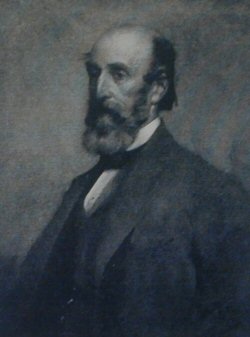 ALEXANDER
SINCLAIR
ALEXANDER
SINCLAIRTHE late managing partner of the Glasgow Herald was born in 1828 at Campbeltown, and was educated there and in Glasgow, whither he came in 1843. His business connection with the Herald began in 1845 by his answering an advertisement for a boy. He was the first boy clerk the company employed, and he rose by successive stages in the office from keeper of the petty cash to the positions of cashier, manager of the commercial and publishing departments, and finally managing partner.
During the fifty-three years in which he served the company vast changes took place. Five successive gentlemen occupied the editorial chair -George Outram,James Pagan, William Jack, LL.D., James H. Stoddart, LL.D., and Charles Russell, LL.D. In 1845 the Herald had oneprinting press, wrought by two men, turning out 400 copies per hour; now it has nine presses driven by electric motors, one of which alone can print, fold, and deliver 1,000 complete Heralds in six minutes, and the paper printed off for a morning issue runs to the extent of 126 miles. In 1845 the electrictelegraph was unknown for newspaper purposes - the first two or three lines of telegraphed news appeared in 1848; but in August, 1904, the judgment and speeches of the Law Lords in the Free Church appeal case, extending to 23œ columns, or about 45,000 words, came over the wires as a single telegram. In 1845 the "taxes on knowledge" still existed - a penny stamp on every printed copy sold or unsold, three halfpence per pound on every kind of paper, and eighteenpence on every advertisement. To-day, thanks to the legislation of 1853, 1855, and 1861, the entireindustry is duty free. In 1845 a copy of the Herald cost 4œd.; it was reduced to 1d. and the issue made daily in 1859. Latest of all the improvements under Mr. Sinclair, the Linotype composing machine has been introduced, by which the operator fingering a keyboard can set, cast, and deliver in lines upwards of seven thousandletters per hour.
The City of Glasgow itself has changed not less in Mr. Sinclair's time. When he came to town the entire space from Blythswood Hill to Argyle Street was laid out in corn fields, and Sauchiehall Street, from Douglas Street to Sandyford, was a somewhat marshy lane with a decayed dyke on the south side. To the architectural changes which have taken place Mr. Sinclair has contributed his part, for one of his last undertakings in the active management of the Glasgow Herald was the erection of the great new offices which form one of the most striking features of Buchanan and Mitchell Streets.
On the completion of his fifty years' connection with the paper his co-partners presented him with his portrait by Sir James Guthrie, now P.R.S.A. (reproduced here), and all theemployees combined to present him with a hall clock with chimes and bells.
As with the Herald connection, Mr. Sinclair's more public career was begun in a small way. When he went to live at Langside about 1870 the roads of the district were almost impassable, Battlefield being a mere narrow watercourse in much the same state as at the time of Queen Mary's overthrow. He took an interest in these roads, and improved them with ashes from the Herald furnace. Presently he was made a Road Trustee, afterwards a County Councillor for Renfrewshire, and when Langside was absorbed by the city he became representative for that ward. Lastly, on the reconstituting of the whole Town Council in 1898, by the rearranging of the twenty-five wards, he was elected third senior Magistrate of Glasgow. It was upon his motion that in 1894 Camphill estate and mansion were purchased by the Corporation from Hutchesons' Hospital for £63,000 and added to the Queen's Park. He also took the initiative, as treasurer, along with Mr. A. M. Scott as secretary, and Mr. Wylie Guild as convener, in the setting up of the Battle Monument at Langside. And he was one of the founders of Camphill U.P. Church. In recognition of his practical interest in the district the committee of the Corporation gave his name to the road running from Battlefield to the River Cart - which is now Sinclair Drive.
Mr. Sinclair has travelled a good deal abroad, his latest and fourth ocean excursion being one to Valparaiso, to visit his youngest son in business there. He is the author also of a highly interesting volume, "Fifty Years of Newspaper Life," printed for private circulation in 1895.